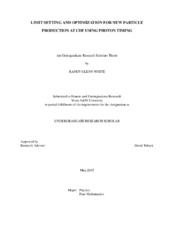| dc.description.abstract | New particles can be produced in high energy proton anti-proton collisions at the Fermi National Accelerator Laboratory (Fermilab). These new particles typically decay very quickly and their decay products can be recorded by the Collider Detector at Fermilab (CDF). In particular, the detector can measure the arrival times of photons produced in the decay of particles created in the interaction. Thus, we may be sensitive to the production of new, massive particles that decay in flight to photons. Such particles can be produced in versions of Supersymmetry, and even be produced as the decay of a Higgs boson. Since the photons that may have come from such events will arrive at the surface of the detector later than photons produced directly from a primary collision, they can be separated in time and analyzed for significance with a nanosecond timing resolution. This analysis is the optimization of the search for these new particles, and the final expected search sensitivity. The results will be the first of their kind, and are expected to set limits as a function of the mass and lifetime of the new particles. | en |


